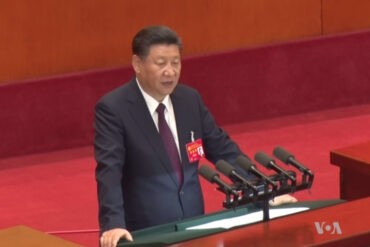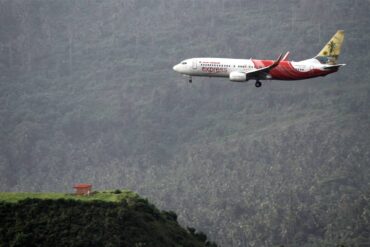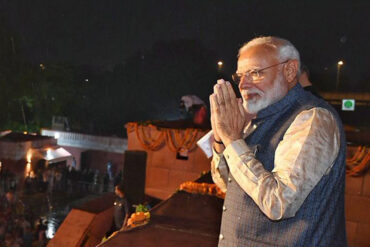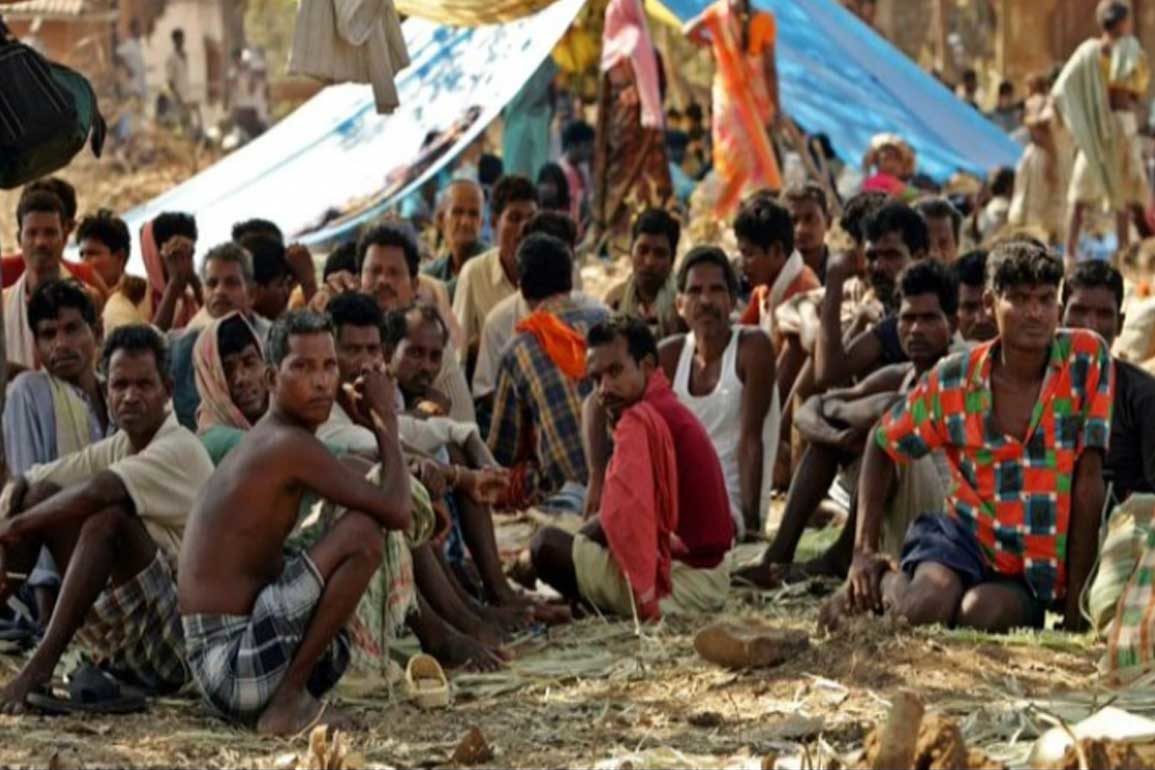As the greatest man made humanitarian crisis since independence plays out across India, prevailing inequalities get intensified due to government policies and approaches during the arbitrarily declared, unplanned lockdown. The curtain of invisibility that hitherto concealed the existence of 10 crore workers, termed migrant workers, has been torn asunder through myriad images of horrendous suffering. This huge section of India’s labour force or rather India’s life force are being stripped of their rights as equal citizens of India. They are, along with all sections of the working class and working people whose basic rights are under attack, are hostage in the war that the Modi government is waging to get out of the huge crisis that the capitalist economy faces.
The so-called package is a reflection of this class war. Millions of men and women workers denied public transport forced to walk hundreds of kilometres is equally a reflection of this war. Among these crores of workers are adivasi workers. One aspect is their common suffering and exploitation with all other migrant workers. The second aspect is the specific deprivations adivasis face as adivasis, as forest dwellers or in villages in hilly areas, which has the specific impact of the lockdown and the so-called package on adivasi lives and livelihood.
Forced to leave their homes and habitats through violent State dictated takeover of their land and forests over the decades, a substantial section of adivasis have joined the urban workforce. The government has no clue as to the social composition of this large labour force. The last NSSO migration survey was published more than two decades ago. It showed that between 1992-1993 to 2007-08, the proportion of migrant households among STs was higher than among all other communities. The same data showed that STs were the single largest group among female migrants. The process of proletarianisation of adivasi communities has been part of the brutal process of the penetration of capitalism in adivasi populated areas. The number of adivasis dependent on wage labour has increased in comparison to those dependent on cultivation and in rural India 65 per cent of adivasis are workers.
With 45.5 per cent of adivasis below the poverty line, adivasis usually do multiple kinds of work through the year—an individual adivasi could be a cultivator, a collector of minor forest produce, an agricultural worker, a labourer in non-agricultural work, all in the course of one year including migrating in search of work. In the name of ease of business, the last several years have seen an accelerated process of displacement and dispossession of adivasi communities and a takeover of their land and forest based resources, increasing the numbers of migrant workers from adivasi communities.
The patterns of adivasi migration are somewhat different than those of other workers. In general, adivasi migration is short term, often seasonal and circulatory in nature both within the state and inter-state. Adivasi migration is mainly for seasonal agricultural work, construction work, work in brick kilns or as manual workers in urban areas. In some states like Maharashtra, large numbers of adivasis migrate for fishing work. This is apart from young adivasi women who migrate to urban areas as domestic workers. The role of labour contractors is more pronounced for adivasi migrants. The pattern of migration is through hiring of groups of adivasi workers by contractors who take them to the designated work place. Contractors often advance payments and the workers are then treated as bonded to the contractor.
Migrations had already started when the lockdown was suddenly imposed. In state after state, adivasis are reporting that work has stopped, the contractors often snubbed by the principal employer, have run away leaving the adivasis stranded. Adivasi migrants, since they are not part of the so-called mainstream cultures are even more vulnerable to the general hostility towards the poor displayed by State agencies particularly the police. During the lockdown, unable to get assistance and despairing of any free travel home, adivasi migrants across India have started the long and painful march home often avoiding highways, travelling through forests and side roads to avoid the police. A list of 1300 adivasi workers from Bastar, who were stranded in the forests of Telangana, was given to the Chhattisgarh government by CPI(M) state secretary.
Of the over 1.4 lakh migrant workers estimated by the Chhattisgarh government waiting to come home from various states at least half would be tribal migrant workers. It is the same for most states which have substantial tribal populations, in particular from the scheduled areas. On the first train which carried workers back to Jharkhand from Hyderabad, at least 45 per cent were adivasis from the districts of Gumla and Simdega. 30,000 adivasis from Jhabua district in Madhya Pradesh are stranded in Gujarat and Maharashtra where they had gone for work. Adivasis from Rajasthan are stranded in Gujarat as are adivasis from Maharashtra. In Palghar district, the intervention of the CPIM party and our MLA ensured the safe return of thousands of adivasis who migrate during the fishing season as workers on fishing boats.
The Inter-State Migrant Workers Act, 1979, the only law for migrant workers, is on the way to being scrapped by the Modi government as part of its agenda of labour reform. It is to be merged with the labour code, which is an instrument to destroy the hard won rights of the working class. Although the 1979 law is inadequate since it deals only with those migrant workers in the contractor system and excludes workers who migrate on their own, for adivasi migrant workers employed through contractors, its implementation would have ensured payment as well as free travel back home. In fact according to the law, the central government is legally liable to ensure free travel home since it is responsible for the termination of the work because of the lockdown.
Most adivasi habitats have so far been free of the virus. Tribals are particularly vulnerable to the virus if it is introduced in tribal areas because of acute vulnerability caused by malnutrition, anaemia. But what happens to the adivasi migrants when they get home is a major concern. How and where are the facilities for quarantine? Arranging quarantine centres outside the villages is a big challenge given the lack of infrastructure. How will testing be done for Covid cases? The health infrastructure in most adivasi inhabited areas is extremely poor. The annual report from the tribal affairs ministry puts the shortfalls in adivasi areas as 20.7 per cent for sub-centres, 26 per cent for primary health centres and 23 per cent for community health centres. The shortfall in the number of doctors is as high as 27 per cent. Shockingly there are no details available on the number of ASHAs in adivasi areas although they are the first line servers in the health hierarchy.
Many of these areas are mineral rich where mining takes place. The district mineral fund which is meant for the development of mining affected people had a total of Rs 35, 925 crore. Reflecting disregard for the needs of affected people, till January this year only 35 per cent had been spent and that too only on infrastructure which would help mining companies. In the first announcement by the finance minister in March, the Modi government arbitrarily permitted use of this fund for Covid control related expenditures. But in these two months not a single rupee has been spent on strengthening the health infrastructure in adivasi areas.
The PDS functioning in adivasi areas, particularly in the hilly regions is generally irregular. Now at the time of lockdown, ground reports point to a looming emergency of hunger and starvation in many adivasi areas. The critical need for free food rations through a universalised distribution system for the next three months is of critical importance in tribal areas. In areas where the Particularly Vulnerable Tribes (PTVs) live, the situation is very grave.
Agriculture in adivasi areas is still mainly subsistence agriculture and only a very small proportion would be for the market. However for their requirements, it is common for adivasi households to sell small quantities of their grain produce in local markets for the cash required for daily expenditures. In this period of lockdown with the closure of local markets and trade, this has not been possible leading to a huge cash crisis in adivasi areas to buy any essential commodities. A direct cash transfer is absolutely essential to save adivasi families from destitution. This is more urgent because of the collapse of the trade in minor forest produce.
From the middle of March to June is the main season for collection of minor forest produce. In most adivasi populated areas, this collection done in substantial measure by adivasi women constitutes 40 to 60 per cent of annual cash income of adivasi communities. MFP collection was allowed only after the first week of April but the weekly markets where most of the collected produce is sold was not allowed. The union minister for tribal affairs wrote to chief ministers to ensure procurement of MFP. Yet at the same time, the minister of MOEFCC advised state governments not to allow adivasis their right to collection because according to this ministry, the danger of humans carrying the virus to animals was to be avoided. As though adivasi need to be taught how to avoid contact with wild animals. This shows the duplicity of the central government which is reflected in poor procurement.
The scheme of the Pradhan Mantri Van Dhan Yojana, the main agency to procure MFP under the Tribal Cooperative Marketing Development Agency (TRIFED) at a minimum support price declared by the government has been a spectacular non-starter. There has been little or no procurement of minor forest produce. On May 1, the official figures given by TRIFED showed that total procurement was just Rs 18.67 crore, out of which Chhattisgarh alone had procured Rs 18.63 crore worth of MFP. A trade which is valued at an annual Rs 20,000 crores bringing some benefit to adivasi communities has totally collapsed. Thus even though there was an increase in the minimum support price of minor forest produce announced by the tribal ministry on May 1, in the absence of government procurement agencies and the non functioning of local markets because of the Covid lockdown, adivasis were forced to make distress sales to traders. Since the minor forest produce is perishable there has been a huge loss incurred by adivasi communities and forest dwellers on the issue of sale of minor forest produce.
In this situation, MNREGA can be of great help. The central government gave permission for MNREGA only from April 20. At present, there are hardly any MNREGA works in adivasi areas, except to some extent in Chhattisgarh. It is critical to start projects in a mission mode in adivasi areas if communities are to be saved from destitution. The MNREGA projects can and should be linked not only to agricultural operations but also for the collection of minor forest produce. This will be a labour subsidy for adivasi women who mainly do this work and can help relieve the acute distress.
Instead of tackling the grave situation prevailing in adivasi areas, the Modi government has used the lockdown to further its pro-corporate agenda including in spheres which directly dilute the constitutional and legal rights of adivasis. The lockdown with its destruction of livelihoods has caused more suffering to adivasis than the coronavirus. But this has been compounded by the use of the lockdown by the Modi government to push through policies which have a devastating impact on adivasi rights. In this period the Modi government has further liberalised mining regulations. This will lead to further displacement of adivasi communities since most mines are situated in adivasi inhabited areas. In the name of “ease of business” the ministry of environment, forests and climate change is fast tracking clearances for projects in forest areas. 31 such proposals in protected areas in forest, tiger reserves, and sanctuaries have been considered for clearance just in this lockdown period.The essential requirement for consent of local communities, most of them adivasis, is being violated.
The proposed draft for dilution of the environment impact assessment for projects is a direct attack on constitutional provisions for protection of adivasi land, of PESA and the Forest Rights Act. The mandatory consultation and consent of gram sabhas for any such projects in Fifth Schedules Areas is sought to be eliminated. The most blatant attack has been in the use of CAMPA funds for afforestation without consultation with the gram sabhas. These funds are the compensation paid by industry for projects which have destroyed forests. At present there is a fund of around Rs 48,000 crores which is in the jurisdiction of state governments where the projects are. Adivasi communities have been the most affected—not only facing displacement by many such projects, but also denial of their rights to forest community resources by the felling of trees.
By arrangement with IPA







